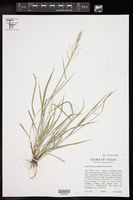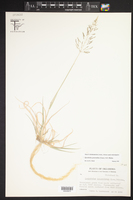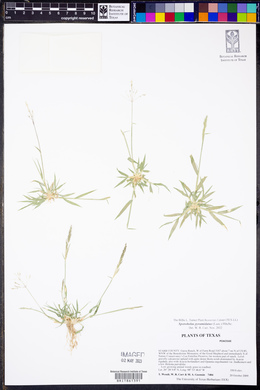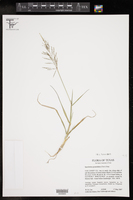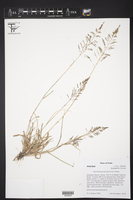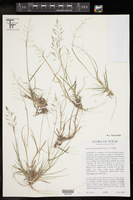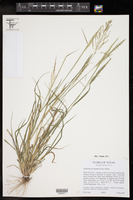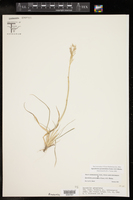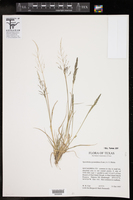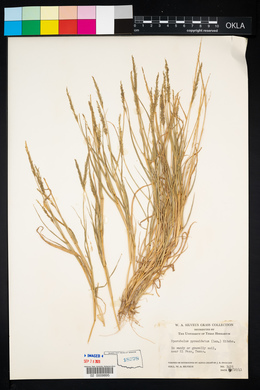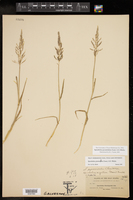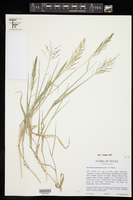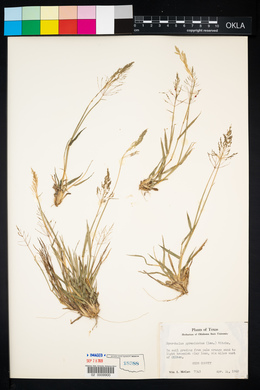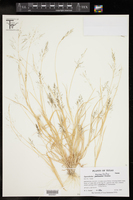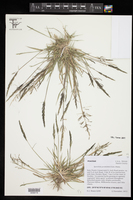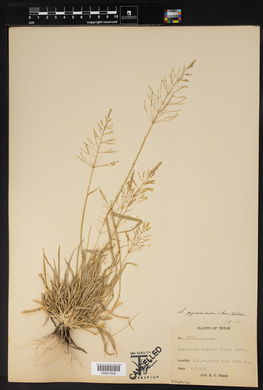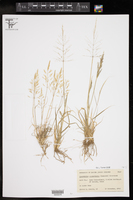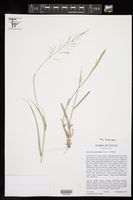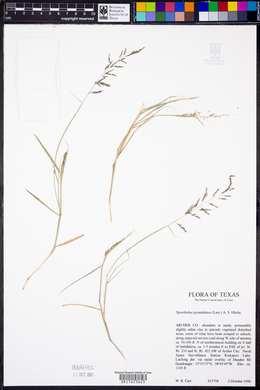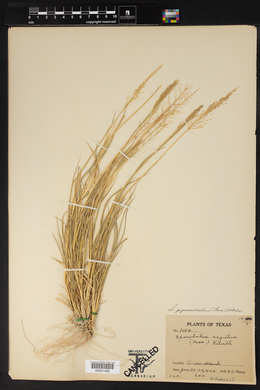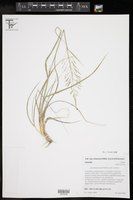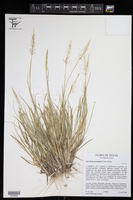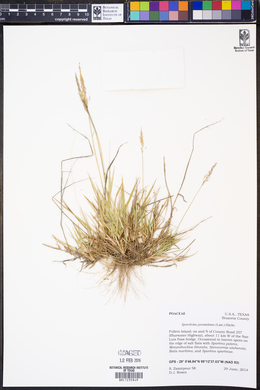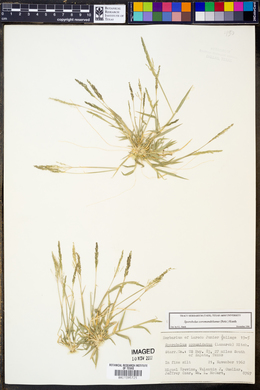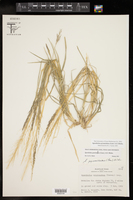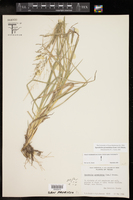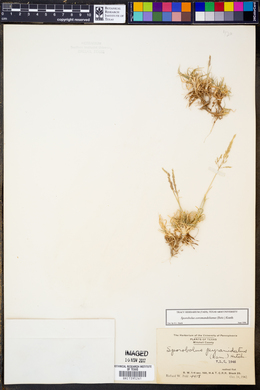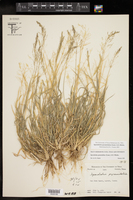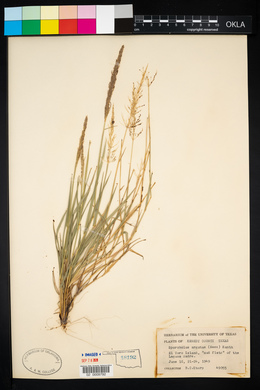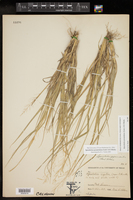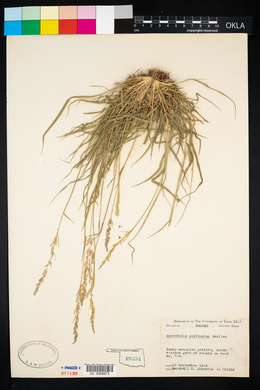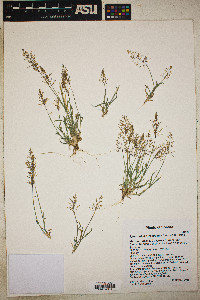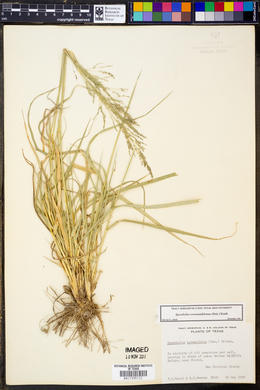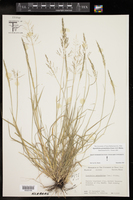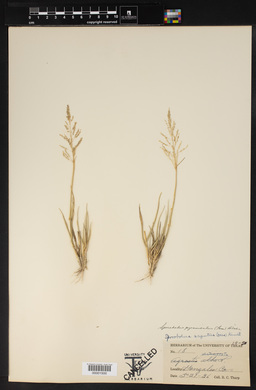Sporobolus coromandelianus
|
|
|
|
Family: Poaceae
Target Dropseed, more...whorled dropseed, Madagascar dropseed, Madagascar dropseed, Whorled Dropseed
[Agrostis coromandeliana Retz., moreAgrostis pyramidata Lam., Sporobolus argutus (Nees) Kunth, Sporobolus commutatus (Trin.) Kunth, Sporobolus parvulus Stent, Sporobolus patens auct. non Swallen, Sporobolus pulvinatus Swallen, Sporobolus pyramidatus (Lam.) A.S. Hitchc., Vilfa commutata Trin.] |
Plants annual or short-lived perennials flowering in the first year; cespitose, not rhizomatous. Culms 7-35(60) cm, erect or decumbent. Sheaths rounded below, margins and apices hairy, hairs to 3 mm; ligules 0.3-1 mm; blades 2-12(20) cm long, 2-6 mm wide, flat, abaxial surface glabrous, adaxial surface scabridulous, sometimes sparsely hispid, margins ciliate-pectinate. Panicles 4-15(18) cm long, 0.3-6 cm wide, open (contracted when immature), pyramidal; lower nodes with 7-12(15) branches; primary branches 0.5-4.5 cm, spreading 30-90° from the rachis, with elongated glands, without spikelets on the lower 1/3-1/2; secondary branches appressed; pedicels 0.1-0.5 mm, appressed. Spikelets 1.2-1.8 mm, plumbeous or brownish, often secund along the branch. Glumes unequal, ovate to obovate, membranous; lower glumes 0.3-0.7 mm, without midveins; upper glumes 1.2-1.8 mm, at least 2/3 as long as the florets, often longer; lemmas 1.2-1.7 mm, ovate to elliptic, membranous, glabrous, acute; paleas 1.1-1.6 mm, ovate to elliptic, membranous, glabrous; anthers 0.2-0.4 mm, yellowish or purplish. Fruits 0.6-1 mm, obovoid, faintly striate, light brownish. 2n = 24, 36, 54. Sporobolus pyramidatus is native to the Americas, extending from the southern United States to Argentina. It grows in disturbed soils, roadsides, railways, coastal sands, and alluvial slopes in many plant communities, at elevations from 0-1500 m. Morphologically, it is very similar to the Eastern Hemisphere S. coromandelianus (Retz.) Kunth, suggesting that they are closely related. FNA 2003, Gould 1980 Common Name: Madagascar dropseed Duration: Perennial Nativity: Native Lifeform: Graminoid General: Tufted annual or short-lived perennial, flowering in the first year; stems erect or decumbent, 7-35 cm tall. Vegetative: Blades 2-12 cm long, 2-6 mm wide, flat, glabrous below, minutely roughened above, with ciliate-pectinate margins; sheaths rounded below, the margins and apices hairy, hairs to 3 mm. Inflorescence: Panicles 4-15 cm long, 0.3-6 cm wide, contracted when young, pyramidal; lower nodes with 7-12 branches; primary branches 0.5-4.5 cm, spreading 30-90 degrees from the rachis, without spikelets on lower third to half; secondary branches appressed; pedicels less than 0.5 mm; spikelets 1-2 mm, one-flowered, brownish, secund along branch (arranged on only one side of the axis); glumes unequal, ovate to obovate, membranous, two-thirds as long as florets; lemmas ovate to elliptic, membranous; caryopsis obovoid, striate, light brownish. Ecology: Found in disturbed sites, on alluvial slopes and along roads and railways below 5,000 ft (1524 m); flowers August-October. Distribution: c US from NV south to AZ and east to IL, PA and NY; south through the Greater Antilles, MEX, C. and S. Amer. Notes: Sporobolus species have single-seeded spikelets with unequal glumes, no awns, and most often small seeds which readily fall after maturing hence the common name -dropseed.- This species distinguished as being an annual; lower nodes of the panicle with 7-20 branches, giving a pyramidal shape to inflorescences; and short, appressed pedicels. Ethnobotany: Unknown Synonyms: Agrostis pyramidata, Sporobolus argutus, Sporobolus patens, Sporobolus pulvinatus, Sporobolus coromandelianus Editor: SBuckley 2010, FSCoburn 2015, AHazelton 2015 Etymology: Sporobolus is Greek for "seed-caster,- while pyramidatus means pyramid shaped. Tufted perennial (often blooming the first year) 1-7 dm, usually ascending or prostrate; lvs crowded at base; sheaths pilose at the throat; blades flat, 5-20 cm נ2-4 mm, sparsely long-ciliate toward the base; panicle pale, pyramidal, 3-10(-20) נ1.5-6+ cm, the lower branches whorled, widely spreading, somewhat viscid, closely fld, naked toward the base; spikelets pale, 1.2-2 mm; first glume 0.3-1 mm, the second equaling the lemma; 2n=24, 36. Sandy or gravelly soil, along the seashore and in alkaline soil in the interior, sometimes a street-weed; trop. Amer., n. to Kans. and Mo., and as an adventive to N.Y. (S. argutus) Gleason, Henry A. & Cronquist, Arthur J. 1991. Manual of vascular plants of northeastern United States and adjacent Canada. lxxv + 910 pp. ©The New York Botanical Garden. All rights reserved. Used by permission. |
|
|
|






